This post will concentrate on stating exactly how the code requirements are intended to be interpreted. They might not reflect other realities, but they are a set of rules that is intended to result in a lower bound capacity being determined.
Firstly I wanted to say, there are some people who are fundamentally misinterpreting the AS4100/NZS3404 provisions in this thread and twisting the words to their own related but incorrect interpretations. I suspect this reply will maybe be meet with further disagreement and requiring endless proofs, which is fine.
I feel sometimes threads on lateral stability sometimes devolve into an argument a little like trying to convince a flat-earther that the world is round or vice versa, despite the common knowledge and education systems and so forth (including real proof) having known for a few centuries that the world is in fact round. No matter of proofs will convince the other side of the argument, this is a fact. I don't mean this to be derogatory at all to those on the alternative side of the debate, but sometimes everyone is wrong about something and this is one of those times I feel with people who have never used the AS/NZS standards trying to say we're applying the provisions which we have grown up with all wrong.
First a bit of background, I was taught steel design by John Butterworth, who was on the original NZS3404 1997 standards committee, he died a few years ago so I cannot ask him for clarification/proof/confirmation or other such things that people contributing to the thread are asking for. More recently I've also worked with a lot of people who have been taught steel design by Charles Clifton who was also on the 1997 standards committee when he was working for HERA. He currently teaches at the University of Auckland.
Now I like to think those guys therefore know what they are on about, and teach the standard in the intent it was meant to be interpreted without any twisting of words being required. After all they wrote and contributed to the standard as it is today. Now while those names might not mean anything to anyone outside of New Zealand, they were and are quite well respected in NZ, having taught generations of Engineers.
No doubt as other Aussies/NZ'ers who have contributed can attest to having been taught, and interpreted the provisions of the standard in the same manner I'm outlining below by other eminent people from this part of the world in the steel/stability world like Nicholas Trahair or Mark Bradford, etc, etc.
TLDR - Believe people who study and work in NZ and AU would know how to correctly apply their own code provisions.
Firstly some background/clarification on definitions so we are talking AS/NZS nomenclature (note all taken from NZS3404, but I'm sure they are similarly defined in AS4100).
Firstly let's look at a support, basically boils down to F or P restraint.
Definition of a member, basically boils down to a segment or number of segments:-
Role and definition of a segment (please note the use of 'cross section' here, more on this later when we get to the critical flange definition):-
Definition of a cross section:-
Well one isn't included, but it's fairly obvious based on the segment definition and the language in the entire remainder of the standard that 'cross section' is actually simply a point along the member where you may apply a restraint or evaluate the member or section capacity.
Definition of critical flange
THE IMPORTANT BITS OF INTERPRETATION ON THE ROAD TO CRITICAL FLANGE DEFINITION IN ACCORDANCE WITH AS4100/NZS3404:-
1 - A
member is the physical member between supports with F or P restraints, or basically also saying you need F or P restraint at supports
2 - A
member can be made up of a number of
segments with F, R, L or U restraints at
segment ends
3 - The
member capacity is determined on a
segment by
segment basis
4 -
Cross section means a point/location at the ends of a
segment where a restraint is applied
5 -
Critical flange is defined as the flange at any
cross section (i.e. at the exact location of the restraint) which in the absence of a restraint at that cross section would deflect the furthest, which one deflects the furthest is determined usually by applying either the requirements of 5.5.2 or 5.5.3. Basically 5.5.2 says at that particular location of the restraint, if the top flange is in compression (for a segment with restraint at both ends) then the critical flange is the top flange. What goes on beyond the location of the restraint is irrelevant for assessing this (I feel this is the point people are missing for applying these provisions).
This is how the requirements are applied and intended to be applied and how they are taught by the people who wrote the standard, etc, etc. You can have an alternative view, but in this particular case you would not be correct.
I'm guilty of not using the correct terminology, the reference to the cross section in the definition means just that. Consider a small slice of the members length as the cross section. So the definition of the critical flange is not based on looking at a member or segment and seeing if it were to buckle as an entire member or segment to see which flange goes furthest. I'm guilty of saying this I think earlier on in the thread (I didn't read back through the first bit as its pretty heavy going!).
For application of the requirement for defining the critical flange all you are doing is looking at the location of the restraint in isolation and classifying the cross section based on the clause 5.5 criteria based on which flange is the compression flange typically as noted in 5.5.2 (though can be both the tension and compression flange for a restraint on a cantilevered end as noted in 5.5.3).
This is the way it is taught, interpreted, used, a theme noted by several posters here. There is no magic about it or mystery. I think in my brain when I read the criteria for critical flange I convert
cross section to mean
segment as some others have in an effort to understand how to apply the provisions. But this isn't the case if you fully want to apply it as intended. It says cross section for a specific reason.
I certainly always apply it based on the actual cross section and forces present only at the location of the restraint, as does everyone else who I've ever run into who actually practices in AS/NZS. I'm sure the other posters will back me up if I say this is it, anything else is incorrect. Tomfh and others have tried to explain how to interpret, or at least say other interpretations are not correct.
The rest of the length of the segment could be in a big black box for all I care for applying these provisions, you don't need to know what is going on along the segment. It is 100% irrelevant for application of the restraint/critical flange requirements. You only need to know the compression flange at the point of restraint.
What goes on along the member is allowed for elsewhere as is member imperfections/residual stresses/moment distribution in the form of the alpha_m and alpha_s factors.
I would point out when making comparison regarding different codes and people saying we're all doing it wrong down in this part of the world. The AS4100/NZS3404 curves are far more conservative than AISC curves for lateral torsional buckling, or alternatively the AISC curves are far less conservative than the AS/NZS capacities. So maybe you nothern types are doing it wrong, a debate for another day perhaps..... All I know is if designed correctly following your code of choice, shit shouldn't fall down.
My understanding is that this is because the AS/NZS curves are scaled to all be lower than experimental results (the 0.6 factor in the alpha_s calculation is responsible for this). As opposed to AISC which takes more or less an average path through all the experimental data, accepting that some real members could in fact have a lower capacity than predicted by the code. For example, here's something I prepared earlier comparing the capacity between AS\NZS and AISC codes for the same member/situation:-
Tom... said:
You would need to show that AS4100 as written overestimates buckling capacity. If you can do that it would be a very important contribution.



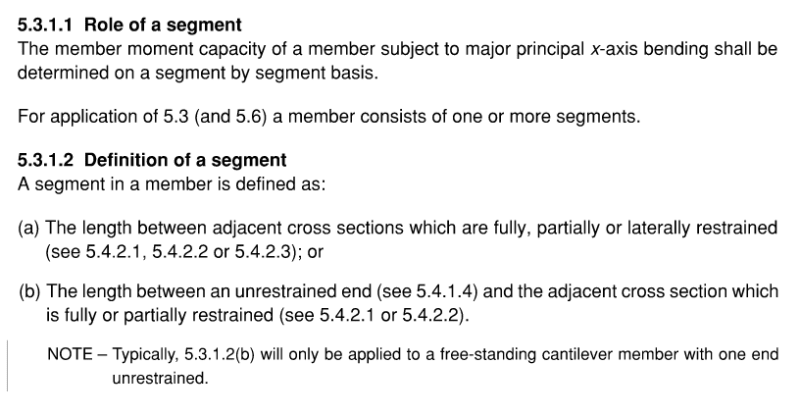
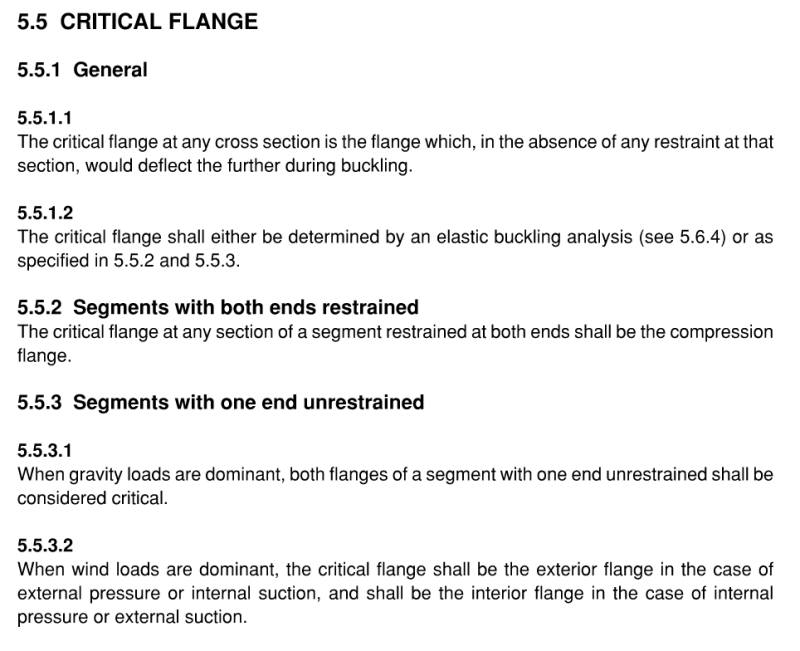
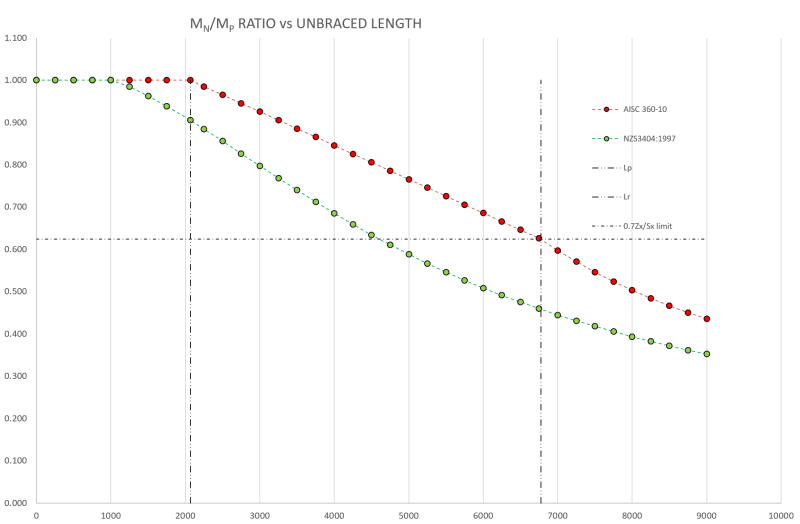
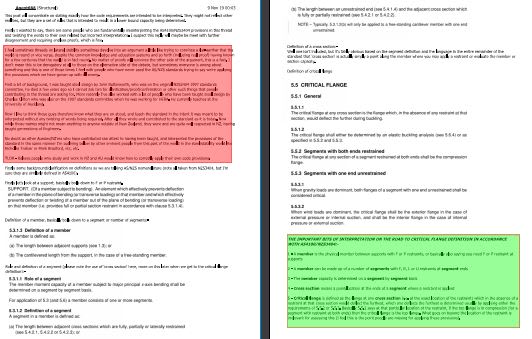
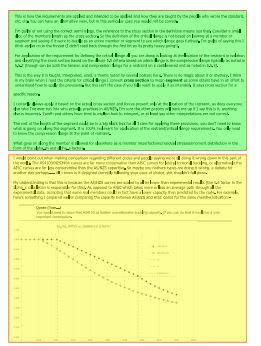
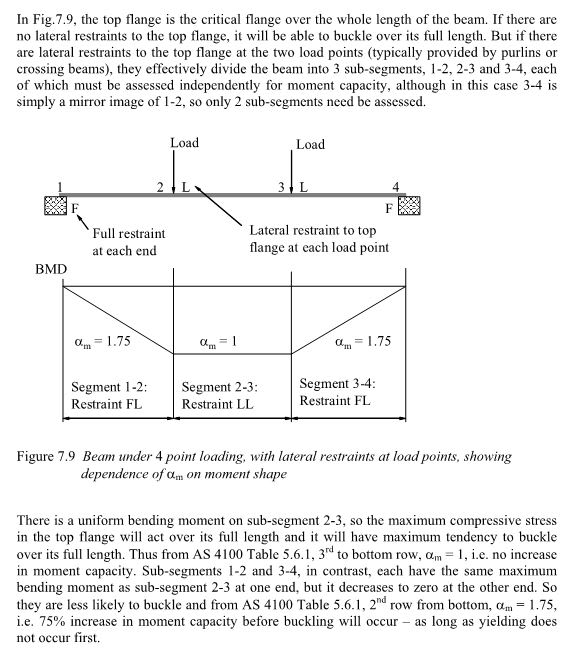

![[smile] [smile] [smile]](/data/assets/smilies/smile.gif)